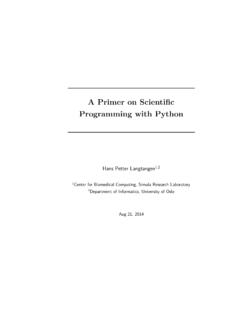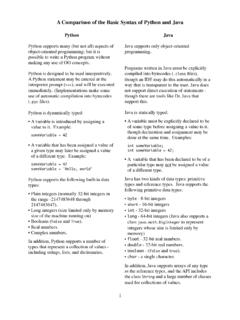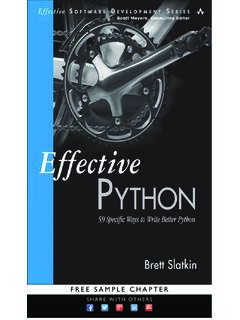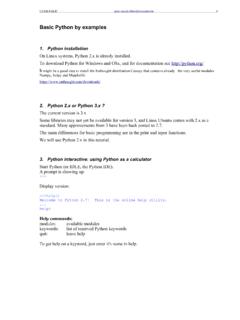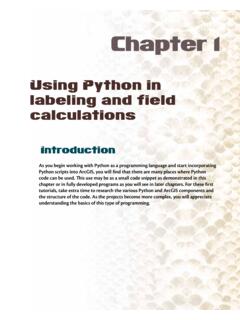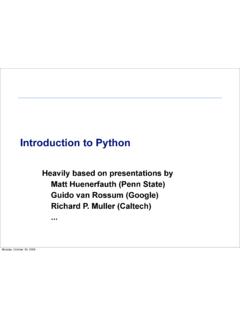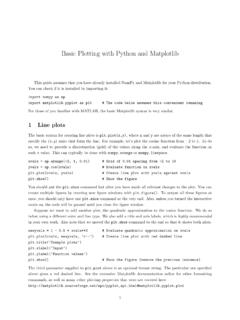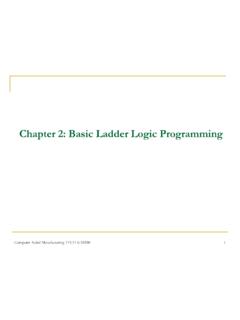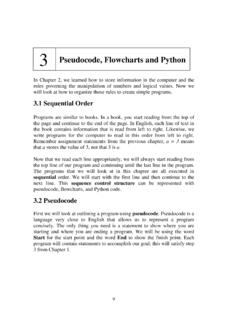Transcription of Guide to the BASIC Programming Language - Salford Systems
1 Guide to the BASIC Programming Language This Guide provides an overview of the built-in BASIC Programming Language available within SPM . 2 2018 by Minitab Inc. All rights reserved. Minitab , SPM , SPM Salford Predictive Modeler , Salford Predictive Modeler , Random Forests , CART , TreeNet , MARS , RuleLearner , and the Minitab logo are registered trademarks of Minitab, Inc. in the United States and other countries. Additional trademarks of Minitab, Inc. can be found at All other marks referenced remain the property of their respective owners. Salford Predictive Modeler Guide to the BASIC Programming Language 3 BASIC Programming Language Salford Predictive Modeler (SPM) contains an integrated implementation of a complete BASIC Programming Language for transforming variables, creating new variables, filtering cases, and database Programming .
2 Because the Programming Language is directly accessible anywhere in SPM, you can perform a number of database management functions without invoking the data step of another program. The BASIC transformation Language allows you to modify your input files on the fly while you are in an analysis session. Permanent copies of your changed data can be obtained with the RUN command, which does no modeling. BASIC statements are applied to the data as they are read from your dataset and before any modeling takes place, allowing variables created or modified by BASIC to be used in the same manner as unmodified variables on the input dataset. Although this integrated version of BASIC is much more powerful than the simple variable transformation functions sometimes found in other statistical procedures, it is not meant to be a replacement for more comprehensive data steps found in statistics packages in general use.
3 At present, integrated BASIC does not permit the merging or appending of multiple files, nor does it allow processing across observations. In SPM the Programming work space for BASIC is limited and is intended for on-the-fly data modifications of 20 to 40 lines of code. For more complex or extensive data manipulation, we recommend you use your preferred database management software. The remaining BASIC help topics describe what you can do with BASIC and provide simple examples to get you started. The BASIC help topics provide formal technical definitions of the syntax. Getting Started with BASIC Programming Language Your BASIC program will normally consist of a series of statements that all begin with a % sign. (The % sign can be omitted inside a "DATA block" described later.) These statements could comprise simple assignment statements that define new variables, conditional statements that delete selected cases, iterative loops that repeatedly execute a block of statements, and complex programs with the flow control provided by GOTO statements and line numbers.
4 Thus, somewhere before a model analysis command such as CART GO, STATS or RUN, you might type: % LET BESTMAN = WINNER % IF MONTH=8 THEN LET GAMES = BEGIN % ELSE IF MONTH>8 LET GAMES = ENDED % LET ABODE = LOG (CABIN) % DIM COLORS(10) % FOR I= 1 TO 10 STEP 2 % LET COLORS(I) = Y * I % NEXT % IF SEX$="MALE" THEN DELETE The % symbol appears only once at the beginning of each line of BASIC code; it should not be repeated anywhere else on the line. You can leave a space after the % symbol or you can start typing immediately; BASIC will accept your code either way. Our Programming Language uses standard statements found in many dialects of BASIC . Salford Predictive Modeler Guide to the BASIC Programming Language 4 BASIC : Overview of BASIC Components LET Assigns a value to a variable. The form of the statement is: % LET variable = expression Evaluates a condition, and if it is true, executes the statement following the THEN. The form is: % IF condition THEN statement ELSE Can immediately follow an statement to specify a statement to be executed when the preceding IF condition is false.
5 The form is: % IF condition THEN statement % ELSE statement Alternatively, ELSE may be combined with other IF THEN statements: % IF condition THEN statement % ELSE IF condition THEN statement % ELSE IF condition THEN statement % ELSE statement Allows for the execution of the statements between the FOR statement and a subsequent NEXT statement as a block. The form of the simple FOR statement is: % FOR % statements % NEXT For example , you might execute a block of statements only if a condition is true, as in %IF WINE=COUNTRY THEN FOR %LET FIRST=CABERNET %LET SECOND=RIESLING %NEXT When an index variable is specified on the FOR statement, the statements between the FOR and NEXT statements are looped through repeatedly while the index variable remains between its lower and upper bounds: Salford Predictive Modeler Guide to the BASIC Programming Language 5 % FOR [index variable and limits] % statements % NEXT The index variable and limits form is: %FOR I= start-number TO stop-number [ STEP = stepsize ] where I is an integer index variable that is increased from start-number to stop-number in increments of stepsize.
6 The statements in the block are processed first with I = start-number, then with I = start-number + stepsize, and repeated until I >=stop-number. If STEP=stepsize is omitted, the default is to step by 1. Nested FOR NEXT loops are not allowed. DIM Creates an array of subscripted variables. For example , a set of five scores could be set up with: % DIM SCORE(5) This creates the variables SCORE(1), SCORE(2), , SCORE(5). The size of the array must be specified with a literal integer up to a maximum size of 99; variable names may not be used. You can use more than one DIM statement, but be careful not to create so many large arrays that you exceed the maximum number of variables allowed (currently 32000). DELETE Deletes the current case from the data set. Operators The table below lists the operators that can be used in BASIC statement expressions. Operators are evaluated in the order they are listed in each row with one exception: a minus sign before a number (making it a negative number) is evaluated after exponentiation and before multiplication or division.
7 The "<>" is the "not equal" operator. Numeric Operators ( ) ^ * / + - Relational Operators < <= <> = => > Logical Operators AND OR NOT Salford Predictive Modeler Guide to the BASIC Programming Language 6 BASIC Special Variables BASIC has five built-in variables available for every data set. You can use these variables in BASIC statements and create new variables from them. You may not redefine them or change their values directly. Variable Definition Values CASE observation number 1 to maximum observation number BOF logical variable for beginning of file 1 for first record in file, 0 otherwise EOF logical variable for end of file 1 for last record in file, 0 otherwise BASIC Mathematical Functions Integrated BASIC also has a number of mathematical and statistical functions. The statistical functions can take several variables as arguments and automatically adjust for missing values.
8 Only numeric variables may be used as arguments. The general form of the function is: FUNCTION(variable, variable, ..) Integrated BASIC also includes a collection of probability functions that can be used to determine probabilities and confidence level critical values, and to generate random numbers. Multiple-Argument Functions Function Definition example AVG arithmetic mean %LET XMEAN=AVG(X1,X2,X3) MAX maximum %LET BEST=MAX(Y1,Y2,Y3,Y4,Y5) MIN minimum %LET MINCOST=MIN(PRICE1,OLDPRICE) MIS number of missing values STD standard deviation SUM summation Salford Predictive Modeler Guide to the BASIC Programming Language 7 Single-Argument Functions Function Definition example ABS absolute value %ABSVAL=ABS(X) ACS arc cosine ASN arc sine ATH arc hyperbolic tangent ATN arc tangent COS cosine EXP exponential LOG natural logarithm %LET LOGXY=LOG(X+Y) SIN sine SQR square root %LET PRICESR=SQR(PRICE) TAN tangent The following shows the distributions and any parameters that are needed to obtain values for either the random draw, the cumulative distribution, the density function, or the inverse density function.
9 Every function name is composed of three letters: Key-Letter: This first letter identifies the distribution. Distribution-Type Letters: RN (random number), CF (cumulative), DF (density), IF (inverse). BASIC Probability Functions CART BASIC also includes a collection of probability functions that can be used to determine probabilities and confidence level critical values, and to generate random numbers. The following table shows the distributions and any parameters that are needed to obtain values for the random draw, the cumulative distribution, the density function, or the inverse density function. Every function name is composed of two parts: The "Key" (first) letter identifies the distribution . Salford Predictive Modeler Guide to the BASIC Programming Language 8 Remaining letters define function: RN (random number), CF (cumulative), DF (density), IF (inverse). Distribution Key- Letter Random Draw (RN) Cumulative (C) Density (D) Inverse (I) Comments ( is the probability for inverse density function) ---------------------------------------- ---------------------------------------- -------------------------------------- Beta B BRN BCF( ,p,q) = beta value BDF( ,p,q) p,q = beta parameters BIF( ,p,q) ---------------------------------------- ---------------------------------------- -------------------------------------- Binomial N NRN(n,p) NCF(x,n,p) n = number of trials NDF(x,n,p) p = prob of success in trial NIF( ,n,p) x = binomial count ---------------------------------------- ---------------------------------------- -------------------------------------- Chi-square X XRN(df) XCF( 2,df) 2 = chi-squared valued XDF( 2,df) f = degrees of freedom XIF( ,df)
10 ---------------------------------------- ---------------------------------------- -------------------------------------- Exponential E ERN ECF(x) x = exponential value EDF(x) EIF( ) ---------------------------------------- ---------------------------------------- -------------------------------------- F F FRN(df1,df2) FCF(F,df1,df2) df1, df2 = degrees of freedom FDF(F,df1,df2) F = F-value FIF( ,df1,df2) ---------------------------------------- ---------------------------------------- -------------------------------------- Gamma G GRN(p) GCF( ,p) p = shape parameter GDF( ,p) = gamma value GIF( ,p) ---------------------------------------- ---------------------------------------- -------------------------------------- Logistic L LRN LCF(x) x = logistic value LDF(x) LIF( ) ---------------------------------------- ---------------------------------------- -------------------------------------- Normal (Standard) Z ZRN ZCF(z) z = normal z-score ZDF(z) ZIF( ) ---------------------------------------- ---------------------------------------- -------------------------------------- Poisson P PRN(p) PCF(x,p) p = Poisson parameter PDF(x,p) x = Poisson value PIF( ,p) ---------------------------------------- ---------------------------------------- -------------------------------------- Studentized S SRN(k,df) SCF(s,k,df) k = parameter SDF(s,k,df) f = degrees of freedom SIF( ,k,df) ---------------------------------------- ---------------------------------------- -------------------------------------- Salford Predictive Modeler Guide to the BASIC Programming Language 9 ---------------------------------------- ---------------------------------------- -------------------------------------- t T TRN(df) TCF(t,df) df = degrees of freedom TDF(t,df) t = t-statistic TIF( ,df)
